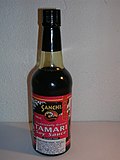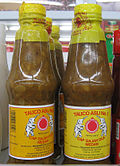List of fermented soy products
Appearance
This is alist of fermented soy products.A diverse variety of soy food products made fromfermentedsoybeansexists.
Fermented soy products
[edit]| Name | Image | Origin | Description |
|---|---|---|---|
| Akhuni(axone) |  |
Nagaland,India | Axone is regarded as Sümi's (Sema) special dish, which is made of fermented soybean. Soybean is boiled, transferred to a bamboo basket and covered with leaves - preferably banana leaves. The basket is placed in a warm, humid place such as over a furnace. After several days, the fermented soybean is mashed, made into thick flat cakes and wrapped in leaves which are then smoked over a fire for up to a week before cooking. It is usually cooked with smoked pork. |
| Bekang | Mizoram,India | Fermented with a small amount of wood-ash for three days after boiling. Mix in the traditionalBaidish. | |
| Hawaijar | Manipur,India | Whole soybeans fermented without salt, Hawaijar is used for making piquant relishes called ametpas as well as thick hearty stews such as Changempomba along with leafy greens and fish.[1] | |
| Cheonggukjang |  |
Korea | A fermented soybean paste used inKorean cuisinethat contains whole as well as ground soybeans; similar to nattō. |
| Doenjang |  |
Korea | A traditionalKoreanfermented soybean paste. Its name literally means "thick paste" inKorean. |
| Doubanjiang |  |
China | A spicy, salty paste made from fermentedbroad beans,soybeans, salt, rice, and various spices. Doubanjiang exists in plain and spicy versions, with the latter containing redchili peppersand calledla doubanjiang.It is used particularly inSichuan cuisine. |
| Douchi |  |
China | Used in thecuisine of China,where it is most widely used for making black bean sauce,[2]the preparation process and product are similar toogiriandiru,both being African fermented bean products. |
| Fermented bean paste |  |
EastandSoutheast Asia | A category of fermented foods typically made from ground soybeans, which are indigenous to the cuisines of East and Southeast Asia. In some cases, such as in the production ofmiso,other varieties of beans such as broad beans, may also be used.[3] |
| Gochujang |  |
Korea | A savory and pungent fermented Koreancondimentmade from red chili, glutinous rice, fermented soybeans and salt. Traditionally, it has been naturally fermented over years in large earthen pots outdoors, more often on an elevated stone platform, calledjangdokdae. |
| Jajangmyeon |  |
Shandongregion, China | Consists of wheatnoodlestopped with a thick sauce made ofchunjang(a salty black soybean paste), dicedporkandvegetables,and sometimes alsoseafood.The dish originated fromzhajiangmianin China's Shandong region. |
| Kinema |  |
Nepal and India(Darjeeling and Sikkim) | A fermented soybean product indigenous to Nepal, mostly prepared by Rais and Limbus of Eastern Nepal. The traditional method of kinema preparation involves cooking of soybeans, cooling to room temperature, mixing with a small amount of vegetable ash, wrapping in banana leaves or rice straw, leaving it for 2–3 days in warm place for fermentation. It has slimy appearance and has a persistent nutty to musty flavor. Kinema resembles characteristics of Natto. |
| Mianchi | China | Similar to douchi but made with white soybeans | |
| Miso |  |
Japan | A traditionalJapanese seasoningproduced by fermentingrice,barley,and/or soybeans with salt and the funguskōjikin(Khúc khuẩn),the most typical miso being made with soy. The result is a thick paste used for sauces and spreads, pickling vegetables or meats, and mixing withdashisoup stock to serve asmiso soupcalledmisoshiru(Vị tạch trấp),a Japanese culinary staple. |
| Nattō |  |
Japan | A traditional Japanese food made from soybeansfermentedwithBacillus subtilis.[4]It is especially popular as a breakfast food.[5]As a rich source ofprotein,nattō and the soybean pastemisoformed a vital source ofnutritioninfeudal Japan.[citation needed]Nattō may be anacquired tastebecause of its powerful smell, strong flavor, and slimy texture.[6][7][8][9] |
| Pickled tofu |  |
China | A form of processed,preservedtofuused inEast Asian cuisineas acondimentmade from soybeans. The ingredients typically are soybeans, salt, rice wine and sesame oil or vinegar, and are sold in jars containing blocks 2- to 4-cm square by 1 to 2 cm thick soaked in brine with select flavorings.[10] |
| Soy sauce |  |
China | A condiment produced from a fermented paste of boiled soybeans, roastedgrain,brine,andAspergillus oryzaeorAspergillus sojaemolds.[11]After fermentation, the paste is pressed, producing a liquid, which is the soy sauce, and a solid byproduct, which is often used as animal feed.[12]Soy sauce is a traditional ingredient in East and SoutheastAsian cuisines,where it is used in cooking and as a condiment. It originated in China in the 2nd century BCE and spread throughout Asia. In recent times, it is used inWestern cuisineand prepared foods. See also:Sweet soy sauce. |
| Stinky tofu |  |
China | A form of fermentedtofuthat has a strongodor.Unlikecheese,stinky tofu fermentation does not have a fixed formula forstarter bacteria;wide regional and individual variations exist in manufacture and preparation. The traditional method for producing stinky tofu is to prepare a brine made from fermentedmilk,vegetables, and meat; the brine can also include driedshrimp,amaranthgreens,mustard greens,bamboo shoots,andChinese herbs.[13]The brine fermentation can take as long as several months. |
| Tamari |  |
Japan | Produced mainly in theChūbu regionof Japan,tamariis darker in appearance and richer in flavor thankoikuchi,Japan's most-produced soy sauce. It contains little or no wheat. Wheat-freetamarican be used by people withgluten intolerance.It is the "original" Japanese soy sauce, as its recipe is closest to the soy sauce originally introduced to Japan from China. Technically, this variety is known asmiso-damari(Vị tạch lưu り),as this is the liquid that runs offmisoas itmatures. |
| Tauchu | China[citation needed] | A paste made from preserved soybeans and often used when steaming fish inHubei cuisine. | |
| Tauco |  |
Indonesia | A paste made from preserved fermented yellow soybeans inChinese Indonesian cuisine.The name comes from the pronunciation in theHokkiendialect and it is originated from China. The sauce is also commonly used in otherIndonesian cuisinestraditions, such asSundanese cuisineandJavanese cuisine.The sauce is often used as condiment and flavoring forstir frieddishes. |
| Tempeh |  |
Indonesia | A traditional soy product originally from Indonesia. It is made by a natural culturing and controlledfermentationprocess that binds soybeans into a cake form, similar to a very firm vegetarianburger patty.Tempeh is unique among major traditional soy foods in that it is the only one that did not originate from theSinospherecuisine. |
| Thua nao | 
|
Myanmar,Thailand | Fermented soybeans in fresh or dried forms, indigenous to theShan peopleof Myanmar and Thailand |
| Tianmianjiang(Sweet bean sauce) |  |
China | A thick, dark brown- or black-colored Chinese sauce made from wheat flour, sugar, salt,mantou,and fermented yellow soybeans (the lees left over from the fermentation of soybeans to makesoy sauce). There are many different types of sweet bean sauces depending on the different compositions and the different method of production, and significant regional variations exist. |
| Tungrymbai | India | A fermented soy product indigenous to the Khasi and Jaiñtia tribes inMeghalaya,India. | |
| Tương |  |
Vietnam | A name applied to a variety of condiments, Tương is a fermented bean paste made from soybean and commonly used inVietnamese cuisine.It may range in consistency from a thick paste to a thin liquid. |
| Yellow soybean paste | China | A fermented paste made from yellow soybeans, salt, and water; wheat flour, though not formerly used, is often used as an additional ingredient in the modern day, andpotassium sorbatemay also be used as a preservative. Yellow soybean paste is produced in China and is used primarily inBeijing cuisineand other cuisines ofnorthern China. | |
| Pehak | India | it is prepared with fermented soybeans andBhut Jolokia |
See also
[edit]- List of fermented foods
- List of food pastes
- List of meat substitutes
- List of soy-based foods
- Sweet bean paste
References
[edit]- ^Anand Singh, Thangjam; Nongthombam, Grihalakshmi; Goksen, Gulden; Singh, Harikesh B.; Rajauria, Gaurav; Kumar Sarangi, Prakash (August 2023). "Hawaijar – An ethnic vegan fermented soybean food of Manipur, India: A comprehensive review".Food Research International.170:112983.doi:10.1016/j.foodres.2023.112983.PMID37316061.
- ^Shurtleff, W.;Aoyagi, A.2011. "History of Fermented Black Soybeans (165 B.C. to 2011)."Lafayette, California: Soyinfo Center. 398 pp. (754 references)
- ^The Book of Miso, 2nd ed., by Shurtleff and Aoyagi. Berkeley, California: Ten Speed Press (1985)
- ^Hosking, Richard(1995).A Dictionary of Japanese Food: Ingredients and Culture.Tuttle. p. 106.ISBN0-8048-2042-2.
- ^McCloud, Tina (7 December 1992)."Natto: A Breakfast Dish That's An Acquired Taste".Daily Press.Retrieved25 December2012.
It's a traditional soybean breakfast food from northern Japan and it's called natto. [...] As a breakfast food, natto is usually served over steamed rice and mixed with mustard and soy sauce.
- ^Katz, Sandor Ellix (2012).The Art of Fermentation: An In-Depth Exploration of Essential Concepts and Processes from Around the World.Chelsea Green Publishing. pp. 328–329.ISBN978-1603582865.
Natto is a Japanese soy ferment that produces a slimy, mucilaginous coating on the beans, something like okra. [...] The flavor of natto carries notes ofammonia(like some cheeses or overripetempeh), which gets stronger as it ferments longer.
- ^A., M. (30 March 2010)."Not the natto!".Asian Food.The Economist.Retrieved25 December2012.
... natto, a food that has achieved infamy among Japan's foreign residents.
- ^Buerk, Roland (11 March 2010)."Japan opens 98th national airport in Ibaraki".BBC News.Retrieved25 December2012.
... natto, a fermented soy bean dish that many consider an acquired taste.
- ^"Natto Fermented Soy Bean Recipe Ideas".Japan Centre.Retrieved25 December2012.
Natto are one of those classic dishes that people either love or hate. Like Marmite or blue cheese, natto has a very strong smell and intense flavour that can definitely be an acquired taste.
- ^"Chao/Doufu Ru (Fermented Bean Curd)".19 April 2008.Retrieved2009-11-21.
- ^'Microbiology Laboratory Theory and Application.' Michael Leboffe and Burton Pierce, 2nd edition. pp.317
- ^Schueller, Randy (1997)."Soy Sauce".In Kristine M., Krapp; Jacqueline L., Longe (eds.).How Products are Made.Vol. 3. Detroit: Gale.doi:10.1223/0787615471.ISBN978-0787615475.OCLC271325103.Retrieved14 November2013.
- ^Xiaomi, Tan (2006-06-02)."Stand back! Stinky tofu chain stores arrive in Shenzhen".Shenzhen Daily.Archived fromthe originalon 2013-08-28.

